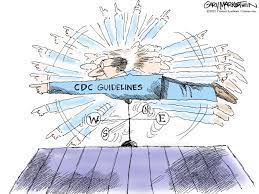The evidence about this Omicron variant is beginning to clarify. The New York Times this morning reported on what is happening in New York City and Seattle:
It now appears that people more and more people are being infected by the Omicron variant, and don't realize it because the symptoms are not so evident. For example:
Some experts believe that the hospitalization gap between the vaccinated and unvaccinated is even larger than these charts suggest. The official data on Covid hospitalizations includes many people who are hospitalized for other reasons — say, a heart condition or a bicycle crash — and who test positive for the virus while being treated. |
About one-third of Covid hospitalizations fall into this category, according to a recent analysis at the University of California, San Francisco. In New York State, 43 percent of people hospitalized with Covid were admitted for other reasons. |
But of course too, if you want to live longer, get vaccinated:
Thus, if you want to take a chance of contracting the Omicron variant and die, don't get vaccinated. Or, looking at it from the sane and safer standpoint:Vaccination remains highly effective at preventing severe Covid illnesses. And Omicron is milder than earlier versions of the virus. The combination means that most Americans — including children and vaccinated adults — face little personal risk from Omicron. |
Finally:
The risk is not zero, to be clear, even among people who are generally healthy. But it is very small. Every day, people live with small risks, be they from the seasonal flu and other illnesses or from riding in a vehicle, playing sports or other activities. |
For the unvaccinated, the situation is very different. Omicron is still severe enough that it will lead to debilitating illness and death for many unvaccinated people. In much of the U.S., a large number of adults — including older adults — remain unvaccinated: |
- The government will cover the cost of over-the-counter, at-home COVID-19 tests.
- Supposedly free for anyone living in the U.S, regardless of insurance or immigration status.
- While those with medical insurance can just go to a pharmacy, or have the kits mailed to them, it is still a little obscure how one with no paid plan can get them. Some hints about coming federal websites and local community centers.
- Begins on January 15, when details will be clarified.
- There will initially be all kinds of shortages.
- You can get 8 free tests/person/month, or in a family of 4, 32 tests/month.
- There is no limit if ordered by a health care provider or doctor.
- Through 2021, the CDC said that more than 700 million COVID-19 tests were taken, with almost 55 million coming up positive. That's about 1 in 13 tests, or 8% positivity.
- The World Health Organization indicates that a positivity rate of 5% or lower is acceptable.
- I can't image how this figure can exceed 100%, but New Jersey and Kansas are above this level at this site, and every U.S. state is higher than 5%.
- On average these tests cost $130 each, although maybe $185 if not insured, or as much as $390 if you were price-gouged.
- In general, home antigen tests in the U.S. are often 3-4 times more expensive than German and India. One reason is that in Europe more than 100 rapid tests have been approved, and only 15 in the U.S.
- For example, yesterday China had 157 new cases and zero new deaths. So what did they do? They just locked down their third city, Anyang, home to 5.5 million. Residents are not allowed to go out....period. Another 13 million in X'ian have now been in this state for three weeks, while Yuzhou, with 1.1 million, has been closed for a week.
- The USA? We had 673,837 new cases and 1093 new deaths. We've closed down nothing.
Good way as any to end my posting today.
-












Comments
Post a Comment